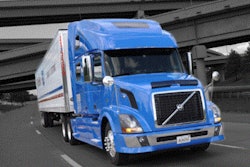People have a lot of advice for drivers and fleets when it comes to what they need to do to improve fuel economy.
One of the classics is telling drivers to slow down.
It is true, in theory, that if you drive more slowly you will get better fuel economy, but how that plays out in the real world doesn't always make sense. Consider this example: by driving slower the driver bumps up against his mandated 36-hour rest, but he is 25 miles short of his delivery location. Driving 2 mph faster would have gotten him to his destination within his legal hours of driving.
In general, drivers are unhappy about going slower because going slower means driving fewer miles, and for drivers who are paid by the mile that means less money. Fleets aren’t necessarily thrilled with lower speeds either because their overhead is nearly the same, but their revenue may be less because of fewer deliveries.
That is not to say that I don’t think speed should be a factor when it comes to fuel economy. I just don't think we can assume that trucks aren’t efficient when they are going 70 mph. In fact, higher speed can equal higher fuel savings and a faster ROI for things like aerodynamic devices. A device that saves 5 gallons per 1,000 miles at 60 mph may save 6 gallons/1,000 miles at 70 mph. The truck uses more fuel at 70 so, yes, it is best to drive slowly. But if you are committed to that speed, you will also see higher fuel savings from aerodynamics and a faster ROI.
I think some fleets are reluctant to spec fuel economy technologies because there is a tradeoff in other areas. Those of us who preach the fuel economy gospel must ensure we are framing fuel efficiency technologies correctly. We need to let fleets know the benefits of the technology, but we also need to let them know what the tradeoffs are. This allows them to make better decisions and likely will result in them being happier with the technology in which they invested because they will have a realistic understanding of what they are trading. In some cases, the tradeoff will be worth it; in others it won’t be.
There are, however, certain things that will have less of an impact on operations while still saving fuel. Aerodynamic mud flaps and upgraded axle oil are two that come to mind. Both of those items not only save fuel, but they also have a positive impact on maintenance. The caveat about aerodynamic mud flaps is that you must choose the right ones, because some lower quality brands have created issues for some fleets.
We all know that trailer skirts reduce drag, thereby improving fuel economy. But they may not be right for fleets that operate in tight delivery zones where the truck bottoms out and the skirts can be damaged. The cost of repairing or replacing the skirt could wipe out any fuel savings the skirt provided. The answer is not necessarily to abandon skirts all together. It could be that the right solution is a shorter skirt or the use of a device that goes under the front of the bogie.
The tractor-trailer gap is another area with tradeoffs. The larger the gap between the tractor and trailer, the more fuel you use. However, gap devices can create problems when backing up or turning, as the devices and can get damaged. Ride is also affected by the position of the fifth wheel. Drivers prefer a fifth wheel set further back for better ride and that is a consideration that should be considered with the driver shortage. Another reason for keeping the fifth wheel back is for weight distribution over the axles.
The bottom line is that not every fleet will see the fuel economy savings that a manufacturer says their product offers. One device might work great for one fleet but is not a good fit for another. Each device needs to be evaluated based on the fleet’s unique operating characteristics.
Fleets should consider engaging the services of a fuel economy consultant who understands both the operational needs of fleet and the benefits and limitation of specific devices given the fleet’s duty cycle. This helps motor carriers make smart decisions that make sense for them.












